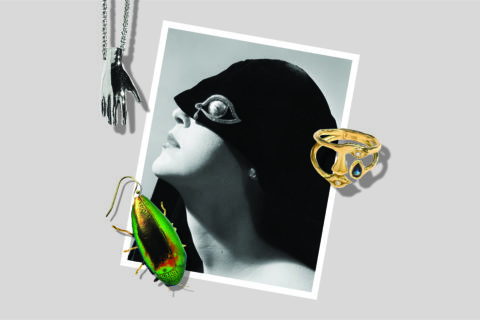Surrealist Jewellery Has Entered the Mainstream
Surrealist jewellery has a storied history, and thanks to creatives like Doja Cat and Daniel Roseberry, the strange, life-like designs are making their way into today's zeitgeist.
Rapper Doja Cat has done more than anyone to push surrealism into the mainstream. Earlier this year, she attended the Schiaparelli Spring 2023 couture show painted lobster red and with 30,000 Swarovski crystals covering her scalp and upper body, each one hand-applied by a team led by makeup artist Pat McGrath. And last year, she wore a black velvet Schiaparelli corset and supersized “ear” earrings that looked like auricular oysters on the half-shell to the Billboard Music Awards.
Body language
The ear is just one of the body parts — along with eyes, noses, fingers and faces — that pop up regularly in surrealist jewellery. They populate the Freudian dream world and repressed subconscious that Salvador Dalí — an avid Schiaparelli collaborator — and other surrealist artists plundered freely for inspiration. Dalí’s “Ruby Lips” brooch, for instance, is an open mouth created from 18-karat gold and rubies with cultured pearls as teeth. In 1949, Dalí produced a diamond-encrusted platinum brooch timepiece called “The Eye of Time.” With a Movado watch movement inserted in the iris and a ruby in the corner of the eye, like a tear duct, it was originally created as a gift for Dalí’s wife, Gala.
There is also Jean Cocteau’s blue-eyed brooch with a fake-pearl teardrop designed for Schiaparelli in 1952 and Man Ray’s “The Oculist,” an eye-shaped brooch crafted from 18-karat gold and malachite. Ray’s first piece of jewellery, made from precious metals, was a necklace he designed in 1961 called “La Jolie.” It is the profile of a face modelled after his wife, Juliet, rendered in 24-karat gold with a lapis lazuli eye. And Schiaparelli’s transparent-rhodoid necklace with metal insects from 1938 has the Luis Buñuel effect of bugs crawling across the wearer’s skin and calls to mind nightmares of being covered in creepy-crawlies — a psychoanalyst’s dream.

Free forms
Besides dreams, surrealists sprinkled their works with the themes of chance and accident. They created them using automatism, a technique whereby the artist surrenders all ideas of intention or design and “goes with the flow.” Alexander Calder perfected a kind of stream of consciousness in his mobile-like jewellery, which was often hammered and bent out of pliable metal that spiralled like scribbling in automatic writing. This was pure thought as object or jewellery.
Funny bones
Among the most celebrated pieces of surrealist jewellery is the fur-covered metal bangle that Meret Oppenheim made in 1936 for Schiaparelli. It was a forerunner of her surrealist masterpiece “Déjeuner en fourrure” featuring a fur-covered teacup, saucer and teaspoon. She also made a humorous gold-plated silver ring set not with a precious gem but with a lump of sugar.
Oppenheim’s objects and jewellery are often visual jokes. Sometimes the humour comes from unexpected slippages between boundaries — like the domesticity of her tea set and the savagery of fur or the contrast of an alluring feminine mouth and the skeletal bones surrounding it in a necklace. Noma Copley’s silver necktie and shirt cuffs, the latter of which look like real shirt cuffs, scramble codes, too, by rendering haberdashery — typically textile items — in metal. The result provokes a double take.
Surrealism today
Daniel Roseberry has scooped up this immense surrealist heritage of comedy and psychoanalysis and brought out 21st-century versions of the jewellery freewheeling through Elsa Schiaparelli’s circle in the 1920s and ’30s. The Schiaparelli creative director accessorized his first collection for the house, in 2019, with a green python necklace with red eyes. It’s reminiscent of Dalí’s “Medusa” brooch in 18-karat yellow gold and platinum-plated gold with oval cabochon sapphires, square cabochon rubies and round diamonds. Roseberry has done teeth chokers, gold nose earrings, keyhole earrings and earrings that look like molars. His eyeglasses feature long-lashed eyes or eyeballs that stop you from seeing anything at all. Instead of rings, Schiaparelli fetishists wear long-nailed gold fingertips and giant ear earrings gleaming with primitivist, surreal splendour.
The house’s jewellery gets bigger every season — like the gold-toned resin breastplate necklace of coral-like lungs and, for the Spring 2022 couture collection, the spectacular gold leaf and gem-studded “cage” dress of hand-moulded leather that creates its own runway category: jewellery-to-wear. Other designers playing in the surrealist space include Ileana Makri, Solange Azagury-Partridge and Delfina Delettrez Fendi, who, in addition to having her own surrealist-minded collection, joined Fendi as artistic director of jewellery in 2020.
This article first appeared in FASHION’s November 2023 issue. Find out more here.








